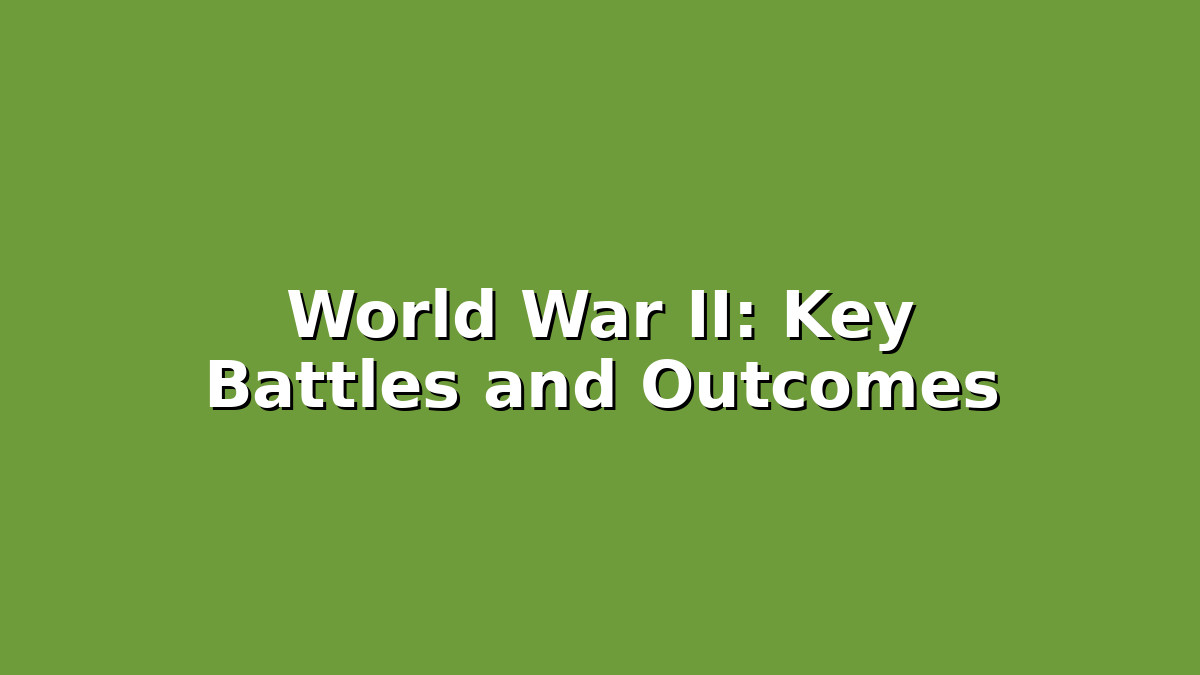World War II remains one of the most significant events in modern history, shaping the world politically, economically, and socially. For students preparing for exams, understanding the key battles and their outcomes is crucial to grasp the broader impact of the war. This comprehensive guide will break down the most important battles, explain their consequences, and provide study tips that will help you remember and apply this knowledge effectively. Whether you’re revising for a history exam or simply want to deepen your understanding, this article will support your learning journey.
1. The Battle of Stalingrad: Turning the Tide in Europe
The Battle of Stalingrad, fought between August 1942 and February 1943, is often considered a major turning point in World War II. This brutal conflict between Nazi Germany and the Soviet Union took place in the city of Stalingrad (now Volgograd) and marked the first major defeat of Hitler’s army.
Why It Matters:
Before Stalingrad, German forces were advancing rapidly into the Soviet Union, threatening to capture key industrial centers. The Soviet victory not only halted this advance but also began a powerful counteroffensive pushing the Germans back westward. The battle was marked by fierce urban warfare and extreme conditions, resulting in massive casualties on both sides.
Study Tip:
Create a timeline of the battle’s events, noting key dates such as the German siege beginning in August 1942 and the Soviet counterattack in November 1942. Using flashcards, focus on important figures like General Paulus (German commander) and General Zhukov (Soviet commander). To remember the battle’s significance, link it to the broader theme of the Eastern Front and how it shifted momentum towards the Allies.
2. The Battle of Midway: The Pacific War’s Turning Point
In June 1942, the Battle of Midway changed the course of the war in the Pacific. This naval battle between the United States and Japan took place near Midway Atoll, a strategic island roughly halfway between Asia and North America.
Why It Matters:
Japan aimed to eliminate the US Pacific Fleet as a threat, hoping to secure dominance over the Pacific. However, thanks to American codebreakers who deciphered Japanese plans, the US Navy was prepared and won a decisive victory. The battle destroyed four Japanese aircraft carriers, severely weakening Japan’s naval power.
Study Tip:
Use maps to visualize the location of Midway Atoll and why it was strategically important. Summarize the battle’s cause-effect relationship: Japanese offensive → American intelligence breakthrough → US victory. Consider making comparison charts showing the naval strength before and after the battle. Remember, this battle shifted the balance of power in the Pacific and set the stage for Allied offensives.
3. D-Day (The Normandy Invasion): Opening the Western Front
On June 6, 1944, Allied forces launched Operation Overlord, the largest amphibious invasion in history, commonly known as D-Day. This invasion began the liberation of Western Europe from Nazi occupation.
Why It Matters:
The successful landing on the beaches of Normandy, France, established a crucial foothold for the Allies, allowing them to advance into Nazi-occupied territories. It forced Germany to fight a two-front war, with the Soviets pushing from the east and the Allies from the west, hastening the end of the conflict.
Study Tip:
Break down the complexity of the invasion by focusing on the five beachheads: Utah, Omaha, Gold, Juno, and Sword. Visual aids such as diagrams and videos can help you understand how the landing was coordinated with airborne drops and naval bombardments. When revising, connect D-Day with the broader strategy of “closing in” on Nazi Germany, emphasizing how it contributed to the eventual Allied victory in Europe.
How to Study WWII Battles Effectively
Understanding World War II’s battles is important, but remembering them for exams can be challenging. Here are some strategies tailored to your exam preparation:
– Use Mnemonics: Create memorable phrases related to battles and dates. For example, “Stalingrad Stops the Storm” can remind you that Stalingrad halted the German advance.
– Engage with Multiple Resources: Don’t rely solely on textbooks. Watch documentaries, listen to podcasts, and explore interactive maps to strengthen your grasp.
– Practice Past Papers: Applying your knowledge to exam-style questions improves recall and helps you identify areas needing reinforcement.
– Group Study: Discussing battles with peers can reveal different perspectives and aid retention.
– Link Battles to Outcomes: Always connect each key battle to its consequences. Understanding why a battle was important helps you remember it better and answers exam questions more effectively.
Conclusion
World War II’s key battles—Stalingrad, Midway, and D-Day—played pivotal roles in shaping the war’s outcome and, ultimately, the world we live in today. By breaking down these battles and focusing on their strategic importance, students can develop a clearer understanding of the conflict’s progression. With the study tips provided, you can approach your revision with confidence and efficiency. Remember, mastering history is not just about memorizing facts but understanding connections and causes. Stay curious, stay consistent, and you’ll be well-prepared to ace your exams.

Responses